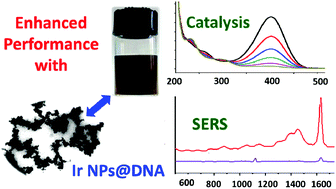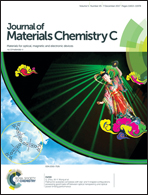Prompt synthesis of iridium organosol on DNA for catalysis and SERS applications†
Abstract
Herein, self-assembled Ir and IrO2 nanoparticles (NPs) were synthesized on DNA scaffolds for the first time in an organic medium using microwave irradiation just for 30 s. By tuning the DNA to Ir3+ molar ratio, stable colloidal Ir and IrO2 NP solutions were obtained in ethanol via reduction with tetrabutylammonium borohydride (TBABH4). The same procedure was executed without DNA to obtain discrete Ir NPs and with DNA (of different Ir3+:DNA molar ratio) for getting chain-like nano-assemblies of IrO2 NPs. The average diameter of the Ir-assembled DNA chains was 40 ± 10 nm, and the average particle size was 3.3 ± 0.5 nm. The synthesized Ir NP@DNA was applied in two different applications: catalysis and surface enhanced Raman scattering (SERS). The catalytic study was conducted for the reduction of various nitro compounds. Ir NP@DNA showed better catalytic activity and recyclability (5–14 times) than Ir NPs obtained without DNA scaffolds. Ir NP@DNA and Ir NPs without DNA were applied to the SERS study by taking methylene blue (MB) dye as a Raman probe molecule. An enhancement factor (EF) value of 8 × 105 for Ir NP@DNA was observed, which was much better than that obtained for our synthesized un-stabilized Ir NPs (1.07 × 105) and other reported Ir NPs. The synthesized Ir NP@DNA and IrO2 NP@DNA were extremely stable for more than 3 months, whereas the Ir NPs synthesized without DNA were not. These stable colloidal solutions were readily re-dispersed in many organic solvents (protic and nonprotic) and could be employed for other potential organic catalysis reactions.



 Please wait while we load your content...
Please wait while we load your content...